Mastering Cardinal Directions: North, South, East, West


Intro
Navigating the vast outdoors can seem daunting, especially if you're not acquainted with the cardinal directions. The ability to determine north, south, east, and west is crucial, whether you're surfing the waves or hiking through dense woods. This guide provides an in-depth look at various methods and tools to help you orient yourself in any environment, fostering not just survival skills, but a profound appreciation of the world around you.
Understanding your surroundings goes beyond just knowing the compass points. Nature offers a wealth of information if one knows where to look. From the position of the sun to the growth patterns of trees, every little detail can help you get your bearings. Additionally, advancements in technology provide us with tools that further enhance our navigation capabilities. Combining traditional wisdom with modern day tech can be a game changer.
As outdoor enthusiasts, it’s vital to cultivate these navigation skills. They not only increase your safety and confidence, but they also deepen your connection to nature. After all, the great outdoors is not just a playground; it’s a realm that must be respected and understood.
Now, let’s delve into some foundational techniques that will serve both beginners and seasoned adventurers alike.
Understanding Cardinal Directions
Understanding cardinal directions is not just about knowing where north, south, east, and west are on a map. It is the very backbone of navigation, serving as an anchor point in an otherwise chaotic world. This knowledge becomes essential whether you're a surfer waiting for the next wave, a hiker discerning paths in the wilderness, or an adventurer mapping your way through unfamiliar territories.
Gaining clarity about cardinal directions offers multiple benefits. For starters, it provides a sense of orientation. When someone can confidently identify where the sun rises and sets, their worldview expands. It’s almost like being equipped with an invisible compass. The ability to discern direction feeds into a broader understanding of one’s environment.
Moreover, understanding these directions can deepen personal safety. In unpredictable conditions, knowing the cardinal points can help you reach safety quicker and avoid hazardous terrain. It's vital when thousands of people flock to the beach, where a sudden shift in wind can change surf conditions, or in rugged terrain where landmarks can become obscured.
Some considerations when learning about cardinal directions include:
- Local geography: Each region presents unique challenges and cues. For instance, mountains may obstruct views of the sky, making celestial navigation trickier.
- Cultural interpretations: Different cultures may interpret directions uniquely, often guided by their environmental context or history.
- Weather conditions: Changes in the weather can influence how directions are perceived. Clouds, fog, or heavy rain might limit visibility of natural indicators like the sun or stars.
Knowing your way isn’t merely a skill; it’s an art that binds you with the elements around you.
In essence, understanding cardinal directions is foundational for anyone venturing into nature or even just navigating daily urban life. This section sets the stage for exploring how direction manifests in various forms, both naturally and through tools like compasses.
The Importance of Knowing Directions
Understanding directions is more than just a compass point; it’s a roadmap to confidence, safety, and adventure. For surfers, instructors, and adventurers, the ability to navigate effectively can mean the difference between an enjoyable day on the waves or a troublesome experience lost to the elements.
Knowing your way around isn't merely a skill; it's a lifeline. When heading out into the ocean or venturing into the wilderness, each direction provides a unique context to your environment. The warmth of the sun rising in the east can be the compass that nudges you eastward, guiding you to your next surf spot or campsite. Understanding these directions fosters not only navigational skills but also awareness of one's surroundings.
Being able to discern north, south, east, and west is crucial in many situations. Whether you’re searching for a secret surf break, camping under the stars, or simply taking a stroll in a new area, knowing which way to go is reassuring. It empowers you to take control of your journey rather than surrender it to chance.
"Navigation isn't just about finding your way; it’s about embracing the journey with a map in your pocket and a compass in hand."
Navigational Skills in Surfing
Surfers can particularly benefit from sharpened navigational skills. Picture this: you arrive at a beach that’s new to you, waves rolling in but the layout is foreign. Without understanding the cardinal points, you might paddle out aimlessly, missing the best waves while those in the know catch them just a few hundred yards up the coast.
Being aware of tidal patterns and how wind direction affects surf conditions also ties back to knowing which way is what. For instance, an offshore wind can create pristine conditions while a consistent onshore breeze can turn waves choppy and less enjoyable. Knowledge of these natural elements ensures you’re making informed decisions, ultimately enhancing your experience on the water.
Moreover, being well-acquainted with local landmarks, such as prominent cliffs or lighthouses, allows surfers to navigate with greater ease. These features often serve as visual cues that help in determining where you are and aiding in finding your way back safely.
Safety Considerations
Navigational skills are not just about following the sun and reading maps; they are a matter of safety. The ocean can be unpredictable—currents can change, and weather can shift with little notice. Having a solid grasp of where you are and the direction in which you are heading is vital.
For instance, if a storm suddenly rolls in, knowing how to orient yourself towards the nearest safe harbor or beach can make a significant difference. Here's a breakdown of considerations that emphasize the importance of direction in ensuring safety:
- Awareness of Hazards: Understanding your bearings helps identify dangerous areas, such as rocky shores or rip currents.
- Planning Escape Routes: Being adept in direction allows you to effectively plan quick escape routes should conditions worsen.
- Communication with Others: If you get separated, the ability to share directions succinctly with others increases the chances of reuniting quickly.
Neglecting the fundamental skills of navigation can lead to dire consequences. Misjudging a course, especially in unfamiliar waters or terrain, can quickly lead to confusion and danger. Therefore, it's imperative to continually refine these skills, ensuring that knowledge of directions becomes second nature. Getting comfortable with both traditional and modern navigational tools can significantly enhance your safety while out and about.
Natural Indicators for Orientation
Understanding natural indicators is crucial for anyone venturing outdoors, especially surfers and adventurers who often find themselves away from urban environments. The elements of nature can serve as traditional guides, providing essential information on cardinal directions. By relying on the environment around them, individuals can not only navigate but also cultivate a profound connection to the wilderness they explore. Ultimately, these indicators allow for improved orientation, safety, and a richer experience in nature.
Using the Sun
The sun is perhaps the most well-known natural compass. At dawn, it rises in the east and, as it sets, it travels across the sky to the west. This daily journey offers a simple yet effective method for determining directions. During midday, the sun reaches its highest position in the sky, usually pointing towards the south in the northern hemisphere.
To effectively use the sun for navigation, individuals can employ their shadows. Here’s a basic technique:
- Stand with your left foot at the sun's noon position (or as close as possible to it).
- Your shadow will extend towards the north, helping you to orient yourself.
This method not only helps find directions but also emphasizes the importance of time—knowing whether it's morning or afternoon can affect the accuracy of your bearings.

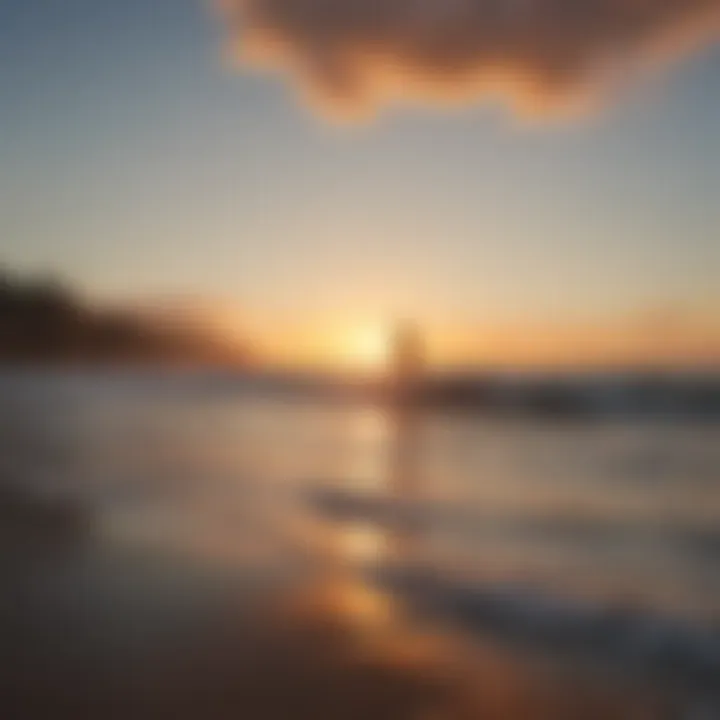
The Role of the Moon
Just like the sun, the moon can assist in navigation. Although its path is less predictable than that of the sun, it still offers valuable guidance. Generally, the moon rises in the east and sets in the west, similar to the sun. However, the crucial difference is its positioning and phase; for instance, a full moon is visible during the night, while a new moon is difficult to see.
A practical tip is to observe the moon's position relative to its phase. When the moon is in a full or gibbous phase, it leans towards the south in the northern hemisphere by about a 30-degree angle, especially around midnight. This can aid in pinpointing southern directions effectively.
Stars and Night Navigation
As daylight fades, a whole new world of guidance emerges in the sky. The stars, especially prominent constellations like the North Star (Polaris), can be vital for nighttime navigation. Polaris is located almost directly above the North Pole; hence, if you can locate it, you’re facing north. Its brightness and fixed position make it a key reference point.
To find Polaris:
- Identify the Big Dipper constellation; it’s shaped like a ladle.
- Follow the line created by the outer two stars of the bowl of the Big Dipper upwards toward a bright star—that bright star is Polaris.
Night navigation isn't solely about finding north. Understanding other prominent stars and constellations can provide insights into east and west as well, creating a celestial map of sorts for intrepid explorers.
Plant and Animal Behavior
Nature is replete with cues from plants and animals that can help in orientation. Certain plants exhibit growth patterns that can indicate cardinal directions— for instance, trees often have denser growth on their southern side in the northern hemisphere, owing to more sunlight exposure.
Additionally, animal behavior can serve as a navigation tool. Birds, many species of which migrate during specific seasons, often take flight towards the east in the morning and west in the evening. Observing the patterns of rabbits or deer might lead you towards water sources, which commonly lie towards the south in many regions.
In summary, incorporating natural elements into navigation strategies can help foster a greater awareness of the surrounding environment and elevate one’s outdoor experiences.
Using Compasses
Understanding how to use a compass is central to mastering navigation. A compass can be a trusted ally, guiding adventurers through the most daunting terrains, where memories of landmarks fade and the complexity of the environment can be overwhelming. Its simple mechanism belies its profound significance in allowing explorers to orient themselves effectively. Being able to read a compass can mean the difference between a successful journey and losing your way in the wilderness.
Types of Compasses
Navigational compasses come in various forms, each suited for specific needs and circumstances. Here are a few common types you might encounter:
- Magnetic Compass: The traditional version everyone is familiar with, this uses Earth's magnetic field to show direction. They're reliable for most navigational purposes.
- Sighting Compass: This type is used for precision aiming, often found in military or surveying contexts. It features a sighting mechanism for accurate bearings.
- Lensatic Compass: A variation of the sighting compass, perfect for hiking or military use. It allows for quick readings and has a sturdy build to withstand rough handling.
- Digital Compass: Often incorporated into GPS devices and smartphones, these compasses provide easy reading and integration with other navigational data.
- Brunton Compass: This is highly specialized, employed mainly by geologists for assessing rock formations. Its unique features cater to scientific needs.
Each type of compass serves its own purpose and offers various features, allowing users to choose one that best fits their navigation style.
How to Read a Compass
Reading a compass is no rocket science, but it does require some practice to get it right. Here’s a simple guide:
- Hold the Compass Flat: Keep the compass level so the needle can move freely.
- Locate North: Wait for the needle to settle, then note where it points. The needle typically points toward magnetic north.
- Align the Compass: Rotate the compass housing until the orienting arrow matches the needle. This adjustment aligns the compass with the Earth's magnetic field.
- Read the Bearing: The degree marker that lines up with the index line gives you the bearing. For instance, a bearing of 270 degrees points west.
- Take Action: Move in the direction indicated while frequently checking the compass to ensure you stay on course.
By following these steps, you'll develop a strong intuition about directions, ensuring that you always know your heading.
Maintaining Your Compass
A compass is like any other instrument; it needs a bit of care and attention to continue functioning well. Here are some key maintenance tips:
- Keep it Dry: Water and moisture can damage the compass. Store it in a dry place when not in use.
- Avoid Magnetic Fields: Steer clear of electronic devices and places with strong magnetic fields, as these can throw off the accuracy of your compass.
- Regular Calibration: With time and use, your compass might stray. Regular calibration can help maintain accuracy.
- Check for Damage: Periodically inspect your compass for scratches or cracks to ensure the glass remains intact. A broken compass is as good as useless in the wild.
Taking these steps can prolong the life of your compass and ensure you'll have a reliable guide whenever you venture out.
Map Reading Skills
Navigating the great outdoors or even your local neighborhood requires a solid understanding of map reading skills. These skills go hand in hand with your ability to determine cardinal directions, making it essential for surfers, instructors, adventurers, and eco-enthusiasts alike. Being able to read a map not only boosts your confidence in exploring new areas but also ensures safety and efficiency in navigating unfamiliar terrains.
Understanding Map Symbols
When you open a map, the myriad of symbols may seem overwhelming at first. However, understanding these symbols is the cornerstone of effective map reading. Each symbol represents something specific—a building, a body of water, road types, and even elevation.
For instance, a blue line might indicate a river, while a green area usually denotes forests or parks. Maps often have a legend or key that explains what each symbol means. Familiarizing yourself with these symbols saves time and enhances your ability to plan routes. Visualizing the terrain ahead can make all the difference when you find yourself in a new location.
"A good map without your ability to read it is like a compass with no needle."
Aligning Maps with Terrain
It's crucial to align your map with the actual terrain if you want to navigate successfully. This practice involves rotating the map until the north on the map matches the north in real life. When you're out in a wild area, aligning your map can reveal a lot about your surroundings; it elucidates where you are in relation to hills, valleys, bodies of water, and more. Some maps even include a topographical contour line that indicates elevation changes, which is particularly useful in identifying highland features or valleys.
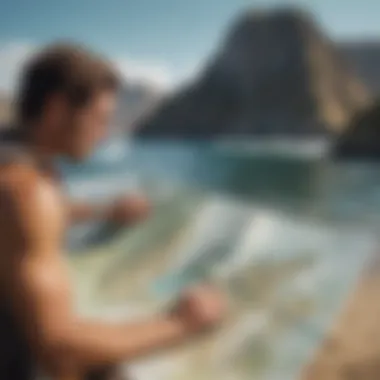
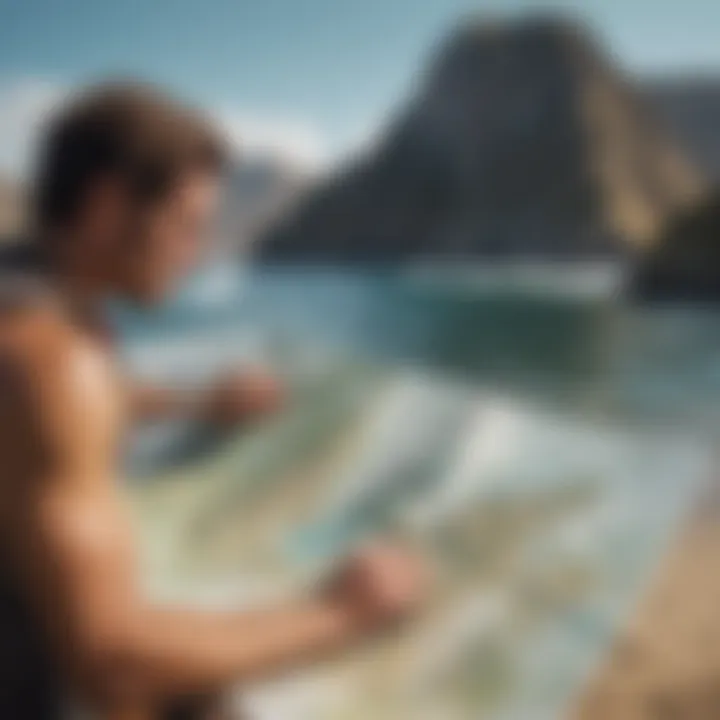
To do this effectively, pointing the map so that terrain features match up with the graphical representations can provide instant insights into what you might encounter on your journey. If you've got a buddy along, have them stand at a landmark and practice aligning it to their position in your head.
Using Landmarks Effectively
Landmarks serve as reference points that can greatly aid your navigation. When reading a map, you're generally trying to match what you see on paper to what’s in front of you. Familiar landmarks like distinctive buildings, unique rock formations, or notable trees can guide you.
In a practical sense, if you know there’s a large oak tree next to a creek on your map, you can use it as a checkpoint on your journey. This not only helps in keeping your bearings but also reinforces your understanding of the terrain and map. Consider combining this technique with your compass reading for even better precision.
Utilizing these elements will help you develop stronger map reading skills that extend beyond just understanding symbols or aligning a piece of paper with the landscape. Practicing these techniques consistently can turn you into a proficient navigator, allowing for safer adventures and more enjoyable experiences outdoors.
Technological Aids in Navigation
In recent years, we’ve witnessed a significant transformation in how we navigate our surroundings. The advent of technology has changed the game for many, offering tools that improve accuracy and efficiency. By incorporating technological aids, navigators—from surf instructors to weekend adventurers—can enhance their directional skills by relying on sophisticated equipment and applications.
GPS Devices
Global Positioning System (GPS) devices are among the most crucial navigational aids available today. GPS technology utilizes a network of satellites to determine one’s precise location almost anywhere on the globe. What’s fascinating about these devices is how they work like magic, receiving signals from at least four satellites to triangulate your position. This technology not only tells you where you are, but it also provides detailed information about roads, trails, and other significant landmarks, which can be invaluable during outdoor activities.
Benefits of using GPS devices include:
- Accuracy: GPS can pinpoint your location within a few meters, depending on the satellite visibility.
- Ease of Use: Many devices offer user-friendly interfaces that display routes and waypoints clearly.
- Additional Features: Some GPS units come with extra tools, such as altimeters or compasses, which can further aid navigation.
However, there are considerations to keep in mind:
- Battery Life: Dependence on electronics means one needs to manage battery consumption carefully.
- Signal Vulnerability: Dense forests or urban canyons may obstruct signals, causing inaccuracies.
In essence, while GPS devices can lead you to your desired destination with remarkable precision, a backup plan—like knowing how to read a compass—remains essential.
Smartphone Navigation Apps
Smartphones have also become staple navigation aids due to their portability and versatility. With a plethora of apps available like Google Maps and Waze, they not only help find routes but also present real-time traffic updates, local business information, and even points of interest.
The appeal of smartphone navigation apps stems from:
- Accessibility: Most individuals carry smartphones with them, providing instant navigation without the need for additional gear.
- Real-Time Updates: Many apps offer live updates which can save significant time during travels by avoiding congested routes.
- User Reviews and Ratings: Finding relevant information about a specific place can be done swiftly thanks to crowd-sourced reviews from users.
Yet, challenges exist:
- Dependence on Connectivity: Many apps require mobile data or GPS signals to function effectively, which may not always be available in remote areas.
- Screen Visibility: Bright sunlight can make smartphone screens hard to read, leading to potential navigation errors.
Overall, smartphone apps provide a modern approach to navigation that is both convenient and useful. However, much like GPS devices, they should complement—rather than replace—traditional navigation skills.
"In the wilderness or the urban jungle, embracing both technology and traditional navigation skills gives adventurers the upper hand."
By combining these technological aids with fundamental navigational skills, surfers and eco-enthusiasts alike can traverse their environments with enhanced confidence and accuracy.
Planning Your Journey
Planning your journey is not merely a preliminary step; it's a crucial phase that anchors the entirety of your navigational experience. For surfers, adventurers, and eco-enthusiasts alike, understanding the routes and potential hurdles before you even set foot out the door can shape the success of your endeavor. When you thoughtfully map out your journey, you solidify your confidence and enhance your connection to the environment.
Pre-Trip Orientation
Pre-trip orientation entails a comprehensive analysis of the location you're planning to explore. This stage lays the groundwork for your adventure, ensuring you're well-equipped with the knowledge to navigate through unfamiliar terrain. Start by reviewing topographical maps and satellite images from platforms like Google Earth or National Geographic. Pay attention to physical features such as rivers, mountains, and coastline—these natural elements can significantly inform your pathways and decisions.
- Research the Area: Familiarize yourself with local landmarks and unique characteristics of the terrain. Note places where you might refuel or where help might be needed, should circumstances take a turn for the unexpected.
- Understand Local Weather Patterns: Weather can turn quicker than a shark's snap! Look up seasonal trends and forecasts to prepare yourself adequately for sun, rain, and wind conditions.
- Equip Yourself with Local Navigation Skills: Learn how locals orient themselves. They often have a wealth of knowledge and tricks to navigate effectively that can considerably enrich your experience.
Identifying Potential Challenges
Even with a well-laid plan, challenges can arise, whether they be natural obstacles or environmental dynamics. Having foresight about these potential challenges can be the thin line between a successful outing and a worrisome mishap.
- Weather Fluctuations: As mentioned earlier, weather is a major player. Sudden storms or a change in wind can affect both comfort and safety, particularly in surfing. Always have alternate plans ready and know how to find shelter.
- Difficult Terrain: Rocky beaches or shallow waters may pose risks while surfing. Knowing where these areas lie can save you from streaining yourself unnecessarily.
- Wildlife Considerations: Being aware of local fauna is vital. Areas may be home to snakes or aggressive marine life. Understanding their habits can keep you safe.
- Cultural or Legal Barriers: Some areas might have local laws governing surfing, camping, or hiking. It’s prudent to familiarize oneself with regulations to respect the culture and avoid fines.
Planning ahead gives you the best shot at navigating both familiar and unfamiliar territories with poise. The more you do in advance, the more time you can spend soaking up the environment rather than scrambling to keep your bearings during your journey.
Practical Exercises in Direction Finding
Practical exercises in direction finding are vital, especially for surfers, adventurers, and eco-enthusiasts who thrive in the great outdoors. Knowing how to confidently determine cardinal directions can be the difference between enjoying the bliss of a sunlit day by the waves and getting hopelessly lost in a dense forest. The importance of this topic cannot be overstated; engaging in hands-on practice solidifies theoretical knowledge and fosters a keen intuition for navigation.
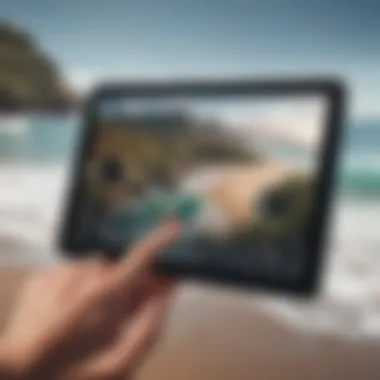
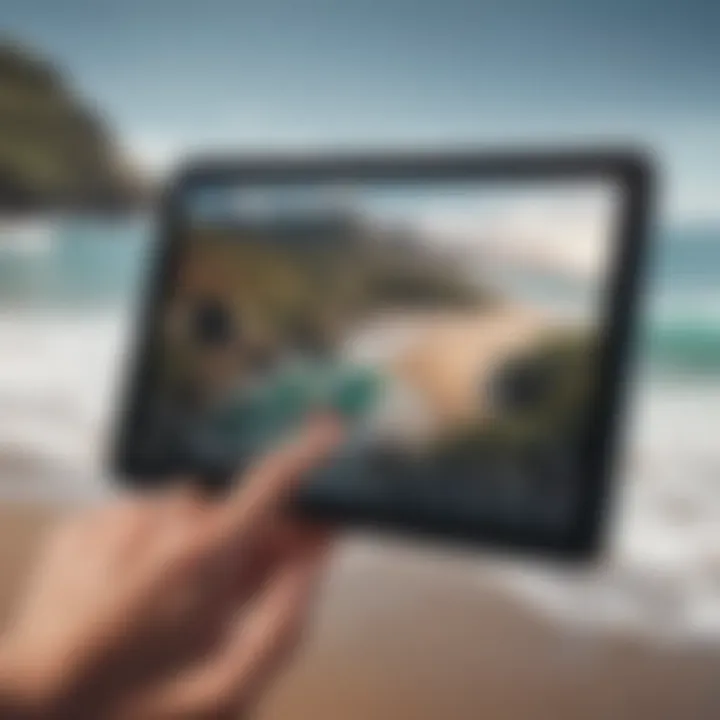
Engaging with the Natural Environment
Engaging with the natural environment to find direction creates a symbiotic relationship between individuals and their surroundings. This experience allows adventurers to develop a deeper appreciation for nature while honing their navigational skills. For instance, using the position of the sun is a time-honored approach. At midday, when the sun is at its highest, it casts shadows directly down. Observing how shadows shift through the course of the day can inform a directional path.
The wilderness offers various cues, such as the growth patterns of trees. In many regions, the southern side of a tree may display more robust growth, as it receives more sunlight. This pattern can serve as a guide. Like anything worth doing, it involves a bit of patience and observation, engaging all senses.
Moreover, take a moment to observe animal behaviors. For instance, migrating birds often fly in specific directions at particular times of the year. Noticing these movements can lend insight into the cardinal points. Integrating these natural elements during exploration proves advantageous not only for navigation but also for fostering greater ecological awareness.
"Nature can teach us far more than a map or a compass ever will, if we only take the time to really see it."
Simulated Navigation Scenarios
Simulated navigation scenarios serve as an excellent method for sharpening directional skills without the risks associated with real-life navigation failures. Picture this: a small group of friends heads to a local park, where they create a mock expedition as if they were on an adventure in uncharted territory. Each participant could take turns receiving instructions to find the marked locations, utilizing compasses, GPS devices, or even just their wits to interpret surroundings.
This controlled environment allows for experimentation. Suppose one participant relies solely on a compass. They learn how to adjust for declination and how terrain features can dramatically influence their path. Meanwhile, another might opt for map reading or rely on a smartphone's GPS capabilities. Each choice unfolds a unique learning experience, offering insights into both the strengths and limitations of various navigational tools.
Incorporating discussions post-scenario can also enhance learning. Asking questions such as, "What worked and what didn't?" or "How did the weather affect our navigation?" can foster valuable reflection. These kinds of exercises bolster confidence and sharpen skills, ensuring that when the time comes to navigate in a real-world setting, participants feel prepared and capable.
Common Mistakes to Avoid
Knowing how to navigate effectively hinges not only on the techniques one employs but also on avoiding common pitfalls that can lead to misdirection and confusion. In this section, we will discuss prevalent mistakes the people tend to make, particularly when using compasses and maps, as well as how to read environmental cues. Learning to steer clear of these errors is crucial in developing reliable navigational skills, especially for surfers, instructors, adventurers, and eco-enthusiasts who thrive on exploration.
Misreading Compasses and Maps
Compasses are powerful tools, but their effectiveness depends largely on how well they are interpreted. A common mistake made is overlooking the variation between magnetic north and true north. Many individuals fail to consider that the compass points toward magnetic north, which can be skewed by local magnetic interference created by metal objects. This often leads to wrong turns in even the most familiar terrain.
Also, when reading maps, always check for cardinal direction indicators. Some maps may not be oriented north at the top; they could be turned to match the landscape. If you're in unfamiliar territory, assuming the map's orientation can lead you into a pickle. A simple rule is to hold your compass flat, ensure the needle is free to rotate, and align it with the map's north indicator before charting a course.
"Navigating effectively requires a sharp eye and a loyal compass; one cannot afford to turn a blind eye to its readings."
Here are some pointers for avoiding misreading compasses and maps:
- Regularly calibrate your compass, if possible, especially in strange locales.
- Familiarize yourself with map symbols before heading out. Different maps can use varying icons, and confusion can arise quickly.
- Practice map reading skills while stationary before hitting the trail or water; this can build confidence.
- Take note of terrain features that can aid in your navigation, enhancing your mental map as you move.
Neglecting Environmental Cues
One of the greatest mistakes navigators commit is ignoring the whispers of nature. The environment around us offers precious clues that can guide our journey if we take the time to observe. Neglecting environmental cues can lead to a disorienting experience, especially when technology fails, such as when cell signals drop or GPS devices malfunction.
For instance, the behavior of animals can serve as a telling sign of direction. Birds often move south in the fall; noticing such patterns can guide you toward warmer climates. Similarly, the position of the sun during the day offers guidance—remember that the sun rises in the east and sets in the west, and at high noon, it is nearly overhead in the tropics. If you forget to factor in these natural indicators, you might find yourself lost, wandering in circles while the answer lies in plain sight.
To better attune yourself to environmental signals, consider these approaches:
- Spend time in the wilderness observing how nature works, noting animal movements and growth patterns.
- Create a habit of checking the sun's position at different times of the day; it can affirm your direction and reassure your course.
- Gather sunset and sunrise times for your location, as they can change dramatically depending on the season.
- Keep a journal chronicling your observations—over time, your connections with the environment will deepen, enhancing your navigational reflexes.
In closing, steering clear of common mistakes will ensure you stay on the right track. Understanding how to read your compass accurately and remaining observant of your surroundings will empower you to navigate with confidence and ease.
Ending: Mastering Directional Skills
In the vast ambient world we navigate each day, mastering directional skills isn't just about finding which way is north or south. It’s about cultivating a deeper awareness of one’s surroundings and developing a keen instinct for orientation. Having a strong grasp of direction is something every surfer, adventurer, and outdoor enthusiast should strive for. It not only enhances personal confidence but boosts safety in various scenarios. Knowing how to read your environment and tools allows you to explore without constantly relying on others, making it a core life skill in today’s fast-paced world.
The skills discussed in this article—ranging from natural indicators like the sun and stars, to the various technological aids at our disposal—form a rich tapestry of resources for anyone involved in outdoor activities. Recognizing how these elements read and interact with each other is crucial. A solid understanding can prevent the common mishaps that lead to confusion or, worse, danger.
“Navigating with confidence is the first wave of success.”
The importance of continuous improvement in these skills cannot be understated. It’s not a one-off effort but a gradual learning process that evolves over time. Building a repertoire of navigational tricks and scenarios equips you for any situation, whether it’s a sudden storm ruining your beach day or a longer trek into the wilderness.
Emphasizing Continuous Learning
When it comes to mastering directional skills, the journey is never truly finished. Consider it an ongoing learning experience that continuously enhances both practical skills and critical thinking. The world isn’t static; environmental shifts and changes in technology can drastically affect how we navigate. Staying ahead requires a willingness to learn and adapt.
Here are some considerations for engaging in continuous learning:
- Participate in Workshops: Find local navigational workshops where experienced instructors can provide hands-on guidance.
- Stay Updated on Technology: Follow recent advancements in navigational tools, such as updates to GPS or navigation apps.
- Engage Online: Join communities on platforms like Reddit where outdoor enthusiasts share tips and best practices.
- Read Widely: Books and articles on navigation can offer new insights and techniques that you might not have considered. Resources like Wikipedia and Britannica can be valuable to gain a better grasp of historical navigation as well.
Integrating Skills into Surfing Practices
Surfing is more than just riding the waves; it’s about becoming one with the ocean. As surfers, navigating the tides and the surrounding environments effectively can not only enhance your overall experience but could one day save your life.
A few ways to merge directional skills into surfing include:
- Recognizing Swell Patterns: Understanding the angle of swells relative to your position can help you choose the best waves to ride. This knowledge ties into the broader skills of observing your environment and how it interacts with the elements around you.
- Using Landmarks: Keeping an eye on shore landmarks while surfing helps in maintaining a sense of direction and can be a guide for returning safely.
- Pre-Surf Briefing: Before heading out, discuss environmental conditions with fellow surfers. Knowing how wind direction and currents affect the surf can improve your overall strategy.
By linking the vital skills of navigation with the art of surfing, one creates a more immersive experience in nature while also ensuring safety and confidence in the water.
Ultimately, mastering these directions is not simply a matter of technique but also about fostering a relationship with the environment. When one understands how to navigate, the world opens up, allowing for deeper explorations and experiences than ever before.















